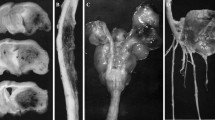Summary
Two groups of male and female Sprague-Dawley rats (50 animals/group per sex) were treated with either 15.37 or 46.77 μmole of 1,1,2-TCE in DMSO/rat for 2 years. The animals were treated once a week by s.c. injection of test compound in the skin of neck. Two groups of controls received either DMSO or no treatment at all. The incidence of benign mesenchymal and epithelial tumors was not significant when compared with either DMSO-treated or untreated controls. The animals treated with 46.77 μmole 1,1,2-TCE significantly developed sarcomas when compared with the untreated controls. In a further experiment, either 40 μmole or 160 μmole 1,1,2-TCE was injected into male Wistar rats and the metabolites, TdGA and HEMA, were determined in 24-h urine samples. Comparative studies were carried out giving equimolar amounts of chloroethanol and 2-chloroacetaldehyde diethyl acetal. Analysis of the metabolites showed that no detectable HEMA was excreted in urine after treatment of rats with 1,1,2-TCE or chloroethanol. TdGA was excreted in urine much more among chloroacetaldehyde-treated animals than among 1,1,2-TCE- or chloroethanol-treated rats.
Similar content being viewed by others
Abbreviations
- 1,1,2-TCE:
-
1,1,2-trichloroethane
- DMSO:
-
dimethyl-sulfoxide
- Hema:
-
hydroxyethyl mercapturic acid
- TdGA:
-
thiodiglycolic acid
References
Abbendandolo A, Bonatti S, Fiorio R, Mazzaccaro A Loprieno N, Barale R, Presciuttini S, Rossi AM, Sbrana I, Stretti G, Zaccaro L (1979) Metodi di studio per L'identificazione di sostanze mutagene. V. Analisi comparativa degli effeti mutageni di contaminanti ambientali mediante diverse metodologie in vitro e in vivo. Atti Associazione Genetica Ital 24:1–2
Bartsch H, Malaveille C, Barbin A, Planche G (1979) Mutagenic and alkylating metabolites of halo ethylenes, chlorbutadienes and dichlorobutenes produced by rodent or human liver tissues. Arch Toxicol 41:249–277
Deitmer A (1980) Quantitive Bestimmung der Thiodiglykolsäure und der β-Hydroxiethylmercaptursäure im Rattenharn nach i.p.-Gabe von Chlorethylenoxid. Doctoral Dissertation, Münster
Guengerich FP, Mason PS, Stott WT, Fox TR, Watanabe PG (1981) Roles of 2-haloethylene oxides and 2-halocetaldehydes derived from vinyl bromide and vinyl chloride in irreversible binding to protein and DNA. Cancer Res 41:4391–4398
Gwinner LM, Laib RI, Filser JG, Bolt HM (1983) Evidence of chloroethylene oxide being the reactive metabolite of vinyl chloride towards DNA: comparative studies with 2,2′-dichlorodiethylether. Carcinogenesis 4:1483–1486
Kinkel HJ (1971) Spontantumoren bei Sprague-Dawley-Ratten. Versuchstierkd 13:97–100
Löhrke H, Hesse B, Goerttler K (1982) Spontaneous tumors in male and female specified pathogen-free Sprague-Dawley rats (outbred stock Sut:SDT). Z. Versuchstierkd 24:225–230
McCann J, Ames BN (1975) A simple method for detecting environmental carcinogens as mutagens. Ann NY Acad Sci 271:5–13
McCann J, Simmon V, Streitwieser D, Ames BN (1975) Mutagenicity of chloroacetaldehyde, a possible metabolic product of 1,2-dichloroethane (ethylene dichloride), chloroethanol (ethylene chlorhydrin), vinyl chloride, and cyclophosphamide. Proc Nat Acad Sci (USA) 72:3190–3193
Müller G, Norpoth K, Eckard R (1979) Identification of S-(carboxymethyl)-L-cysteine and thiodiglycolic acid, urinary metabolies of 2,2′-bis(chloroethyl)-ether in the rat. Cancer Lett 7:299–305
Müller G, Norpoth K (1979) Untersuchungen zur Reaktivität und zum Stoffwechselverhalten halogenierter Äther. Verh dtsch Ges Arbeitsmed 19:205–211
National Cancer Institute (1978) Bioassay of 1.1.2-trichloroethane for possible carcinogenicity. Technical Report Series No. 74, DHEW Publication No. (NIH) 78–1324, US Department of Health, Education and Welfare, Washington DC
Norpoth K, Heger M, Müller G, Mohtashamipur E, Kemena A, Witting C (1986) Investigations on metabolism, genotoxic effects and carcinogenicity of 2,2′-dichlorodiethylether. J Cancer Res Clin Oncol 112:125–130
Page NP (1977) Test animals and animal science. In: Kraybill HF, Mehlmann MA (eds) Advances in modern toxicology, vol 3, environmental cancer. Hemisphere Publishing Corporation, Washington, London, pp 113–119
Rannung U, Göthe R, Wachtmeister A (1976) The mutagenicity of chloroethylene oxide, chloroacetaldehyde, 2-chloroethanol and chloroacetic acid, conceivable metabolites of vinyl chloride. Chem Biol Interact 12:251–263
Rannung U, Sundvall A, Ramel C (1978) The mutagenic effect of 1,2 dichloroethane on Salmonella typhimurium. I.Activation through conjugation with glutathione in vitro. Chem Biol Interact 20:1–16
Simmon VG, Kauhanen K, Tardiff RG (1977) In: Progress in genetic toxicology developments in toxicology and environmental science, vol 2. Proceedings of the 2nd International Conference on Environmental Mutagens. Elsevier/North-Holland Biomedical Press, New York
Squire AR, Brinkhous KM, Peiper SC, Firminger HI, Mann RB, Strandberg JD (1981) Histiocytic sarcoma with a granulomalike component in a large colony of Sprague-Dawley rats. Am J Pathol 105:21–30
Thomson SW, Huseby RA, Fox MA, Davis CL (1961) Spontaneous tumors in the Sprague-Dawley rat. J Natl Cancer Inst 27:1037–1051
Thomson JA, Ho B, Mastovich SL (1984) Reductive metabolism of 1,1,2,2-tetrachloroethane and related chloroethane by rat liver microsomes. Chem Biol Interact 51:321–333
Watanabe PG, McGowan GR, Gehring PJ (1976) Fate of (14C) vinyl chloride after single oral administration in rats. Toxicol Appl Pharmacol 36:339–352
Weißburger EK (1977) Carcinogenicity studies on halogenated hydrocarbons. Environ Health Perspect 21:7–16
Yllner S (1971) Metabolism of 1,1,2-trichloroethane-1,2-14C in the mouse. Acta Pharmacol Toxicol 30:248–256
Zajdela F, Croisy A, Barbin A, Malaveille C, Tomatis L, Bartsch H (1980) Carcinogenity of chloroethylene oxide, an ultimate reactive metabolite of vinyl chloride, and bis(chloroethyl)ether after subcutaneous administration and in initiation-promotion experiments in mice. Cancer Res 40:352–356
Author information
Authors and Affiliations
Rights and permissions
About this article
Cite this article
Norpoth, K., Heger, M., Müller, G. et al. Investigations on metabolism and carcinogenicity of 1,1,2-trichloroethane. J Cancer Res Clin Oncol 114, 158–162 (1988). https://doi.org/10.1007/BF00417830
Received:
Accepted:
Issue Date:
DOI: https://doi.org/10.1007/BF00417830



